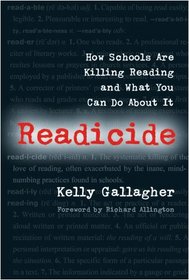Leo T. reviewed Readicide: How Schools Are Killing Reading and What You Can Do About It on + 1775 more book reviews
This is aimed at teachers, urging them to fight the tendency to spend so much time on teaching to the test and using canned reading programs that award points, in favor of authentic reading experiences of various kinds. Published for that audience, it cites the literature (journal articles).
It is useful for parents who want to try to get the curriculum of the schools their kids attend improved and for home schools. Specific pro and con examples are laid out from time to time, i.e. one column with the attributes of fostering good readers and creating struggling readers or developing recreational readers and developing academic readers.
Concerned about high school students having enough practical reading skills to take junior college courses, I myself was interested in getting a credential to teach history (and geography, political science, economics, business, health), with a reading classroom. That is, rather than leave it only to the English Department, we would be reading the textbook chapter, journal articles, a chapter of a specialized book on the era or topic, hearing brief student powerpoints, etc. However, at the turn of the century I could see no way that students would read a hundred pages a week even though I had a couple hundred YA novels on hand so a small group could read and discuss (and bank) a couple hundred pages. Note that Mr. Gallegher mentions 'high interest' reading materials--that is vital. In the end, I worked with small groups of 16-17 year olds on an ad hoc basis who were highly motivated (i.e. they realized they would soon have to make their way in the cold, cruel world). We wound up using mostly non-fiction (most anything they wanted, often HRM) and would meet a couple of times to discuss and practice the varying way one would read a chapter of a book for a detailed quiz or exam, in preparation to hear a lecture, to share the chapter with the group, or if one was very, very interested in the information offered.
Some groups wanted to do fiction so we used a YA novel of interest to the group (S.Cal. has many libraries where we can obtain multiple copies) to read and discuss. I would have a list of prompts (such as 'Will Maria go out with Jim?') since I had taken notes when I read it for the first time; they thus get involved in the story. As Mr. Gallagher says, that is important for a good read and improving the experience of struggling' readers.
Much of the book is somewhat technical, such as English teachers who 'overteach' or 'underteach' books.
Appendixes, references, and index.
It is useful for parents who want to try to get the curriculum of the schools their kids attend improved and for home schools. Specific pro and con examples are laid out from time to time, i.e. one column with the attributes of fostering good readers and creating struggling readers or developing recreational readers and developing academic readers.
Concerned about high school students having enough practical reading skills to take junior college courses, I myself was interested in getting a credential to teach history (and geography, political science, economics, business, health), with a reading classroom. That is, rather than leave it only to the English Department, we would be reading the textbook chapter, journal articles, a chapter of a specialized book on the era or topic, hearing brief student powerpoints, etc. However, at the turn of the century I could see no way that students would read a hundred pages a week even though I had a couple hundred YA novels on hand so a small group could read and discuss (and bank) a couple hundred pages. Note that Mr. Gallegher mentions 'high interest' reading materials--that is vital. In the end, I worked with small groups of 16-17 year olds on an ad hoc basis who were highly motivated (i.e. they realized they would soon have to make their way in the cold, cruel world). We wound up using mostly non-fiction (most anything they wanted, often HRM) and would meet a couple of times to discuss and practice the varying way one would read a chapter of a book for a detailed quiz or exam, in preparation to hear a lecture, to share the chapter with the group, or if one was very, very interested in the information offered.
Some groups wanted to do fiction so we used a YA novel of interest to the group (S.Cal. has many libraries where we can obtain multiple copies) to read and discuss. I would have a list of prompts (such as 'Will Maria go out with Jim?') since I had taken notes when I read it for the first time; they thus get involved in the story. As Mr. Gallagher says, that is important for a good read and improving the experience of struggling' readers.
Much of the book is somewhat technical, such as English teachers who 'overteach' or 'underteach' books.
Appendixes, references, and index.
Wendy R. reviewed Readicide: How Schools Are Killing Reading and What You Can Do About It on + 2 more book reviews
This book is a phenominal read, especially those concerned about the huge gap in print knowledge that students are facing today.




